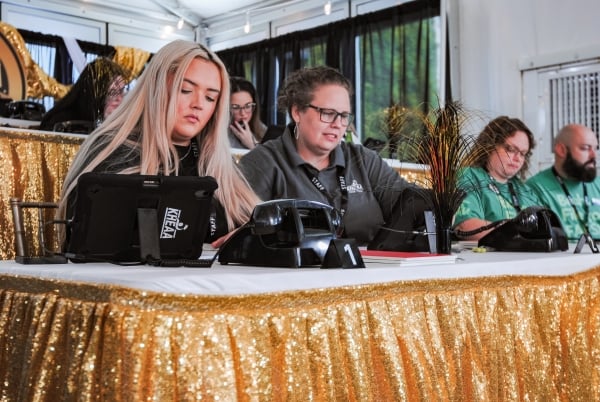You have /5 articles left.
Sign up for a free account or log in.

Keith Ritchie hosts the Kentucky FAFSAthon with a squadron of volunteers ready to help students and families complete the federal aid form.
Courtesy of the Kentucky Higher Education Assistance Authority
Everything glittered at the first-ever Kentucky FAFSAthon.
The buntings and tablecloths shone gold under the fill lights, as did the hosts, Casi Benedict and Keith Ritchie, who sported a matching gold dress and bowtie, respectively. Even the setting was opulent: The program was held at the Kentucky Castle, a faux-medieval estate and events space outside of Versailles (the town in Kentucky, not the site of that other palace in France).
Presented by the Kentucky Higher Education Assistance Authority (KHEAA), the FAFSAthon was streamed live on YouTube from 11 a.m. to 11 p.m. on Tuesday. Benedict and Ritchie—KHEAA’s director and assistant director of outreach services, respectively—guided viewers through 12 uninterrupted hours of programming, including live music, games, skits, a full FAFSA walkthrough and a “dorm room cooking show,” where officials made simple, cheap meals on a portable George Foreman grill.
Just off camera, a team of more than 60 volunteers monitored phone lines and answered questions from students and families—most of whom still hadn’t submitted a federal student aid form. They’d been thwarted by months of delays and technical glitches, with only weeks to go until the start of the fall semester.
Ritchie, who spoke to Inside Higher Ed the next morning from the castle, said KHEAA wanted to create “a festival atmosphere,” and compared the event to a variety show. He said they helped about 100 students complete their FAFSAs—some over the phone, some via text, and a handful in-person.
“This was kind of our last big push of the summer,” he said. “We felt like if we did something really fun and exciting, it could be different enough that it might persuade a student who may have not shown up at a FAFSA workshop earlier in the school year.”

Volunteers monitored the phone lines at the Kentucky Castle.
Courtesy of KHEAA
He and his colleagues, along with the state’s higher ed institutions, are feeling the urgency of the FAFSA crisis as the start of the academic year nears. Kentucky’s FAFSA completion rates are still 12 percent behind this time last year, according to data from the National College Attainment Network (NCAN); just over 50 percent of the state’s high school seniors have filled out a form. While national completion rates recovered from a nearly 40 percent decline in the spring, progress slowed to a near-standstill over the summer; nationwide FAFSA completion is currently 9.9 percent behind last year.
Bill DeBaun, NCAN’s senior director of data and strategic initiatives, said he’s not confident there’s much room for more recovery.
“The numbers are really scary, especially given what we know about the connection between FAFSA completion and enrollment,” he said. “People are working so hard to get those numbers up, but after a certain amount of time, FAFSA cycles tend to kind of peter out. There doesn’t seem to be much juice left to squeeze.”
Staying on the Line
KHEAA bankrolled the event with grants from the U.S. Education Department and the Educational Credit Management Corporation, a federal subcontractor—money that was first authorized for a national “FAFSA Support Fund” in February.
Ritchie said the support has been crucial in keeping Kentucky outreach going during the usually slower summer months. At one point during the FAFSAthon, around the two-hour mark, Ritchie pulled out a rolodex of “every single person in Kentucky who hasn’t completed a FAFSA, but plans to start college in the next few weeks.”
“There are so many halfway done FAFSAs out there, and we wanted to turn as many of those as possible into submissions,” Ritchie said. “Almost everyone who got in touch with us for help, we were able to get them across the finish line.”

KHEAA volunteers greet students who drove to the Kentucky Castle for in-person FAFSA assistance.
Courtesy of KHEAA
As the clock runs out on efforts to bring FAFSA completion in line with previous years, other states are turning to attention-grabbing tactics, too. In Michigan, where only 47 percent of high school seniors have submitted a form, the Detroit College Access Network is holding raffle events that double as FAFSA information sessions. On August 29, they’re raffling off a PlayStation and tickets to a Detroit Lions home game.
DeBaun said that the ideal method of outreach is targeted and individual, using district-level data to find students who need help or encouragement and leveraging state and federal resources to get it to them. But that work, he added, is labor-intensive and often narrow in the scope of its impact. If states and districts are going to make up ground this late in the summer, he said the more innovative and eye-catching their efforts, the better.
“At this point, it’s the events that inspire enthusiasm, that really engage families, that could make the biggest difference,” DeBaun said.
Kentucky isn’t stopping with the FAFSAthon, either. Ritchie said they’ve also used the federal support funds to throw FAFSA tailgate parties in the parking lots of partner high schools, staff a FAFSA helpline every Monday through Thursday and train local volunteers to host FAFSA boot camps in their own districts.
“If folks pay attention and can take one message away from what we’re doing, I hope it’s this: It’s not too late,” Ritchie said.





